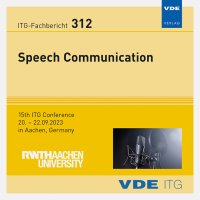Ad Hoc Distributed Microphones Clustering: A Comparative Analysis on Using Coherence and Signal-Specific Features
Conference: Speech Communication - 15th ITG Conference
09/20/2023 - 09/22/2023 at Aachen
doi:10.30420/456164001
Proceedings: ITG-Fb. 312: Speech Communication
Pages: 5Language: englishTyp: PDF
Authors:
Kindt, Stijn; Meeldijk, Martijn; Madhu, Nilesh (IDLab, Department of Electronics and Information Systems, Ghent University - imec, Ghent, Belgium)
Abstract:
It is often useful to cluster hoc distributed microphones according to the dominant source each captures. For example, in a recently proposed source separation approach, inter- and intracluster information is aggregated to enhance the dominant source at each cluster. To generate the features for this blind clustering, spectro-temporal characteristics of the signals are usually exploited to be clustered by the fuzzy C-means algorithm. A recent alternative uses the spatial relations between microphones, encoded by pairwise broadband coherence. Non-negative matrix factorisation of the positive, semi-definite coherence matrix thus obtained directly yields the cluster assignments. Here, we compare these two types of approaches in terms of the resultant cluster quality. However, coherence-based approaches require the transfer of each microphone signal to a central processing node for feature computation - in contrast to the feature-based approaches, which only require transmission of time-aggregated feature vectors. To counter this large bandwidth requirement of the coherence-based approach, we examine its performance under lossy encoding from a standard codec (BLE LC3plus). Results show that, contrary to intuition, the coherence-based approach remains robust to such non-linear encoding - making this a viable option for bandwidth-limited (wireless) acoustic sensor networks.


